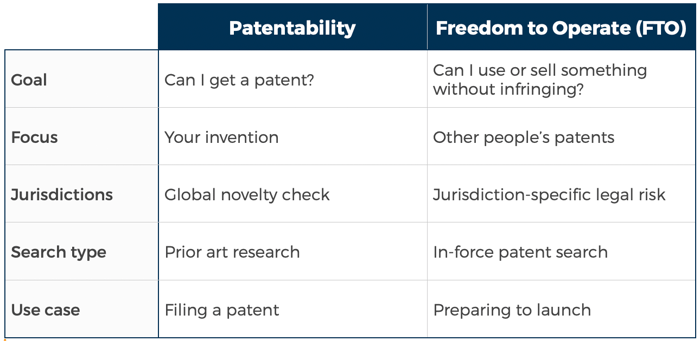Patentability vs. Freedom To Operate
1. Patentability: can you get a patent?
Patentability means your invention meets the criteria required to obtain a patent. It answers the question: Can this idea be protected?
To be patentable, an invention must be:
- Novel – not already disclosed anywhere (including patents, articles, websites, or even your own slides).
- Inventive – not obvious to a professional in the field.
- Industrially applicable – it can be made or used in a concrete way.
→ In short, patentability is about what you can protect.
Example:
You invent a new coil design for wireless EV charging. If no one has published or patented this exact configuration, it might be patentable.
But even if your invention is patentable, you’re not necessarily free to use it — that’s where freedom to operate comes in (next).
2. Freedom to Operate (FTO): are you allowed to use it?
Freedom to Operate (FTO) means you're not infringing on someone else’s patent in the jurisdiction where you want to make, use, or sell your product.
It doesn’t matter if your invention is new or even patented: if someone holds a valid patent covering part of your solution, you may need a license, or you risk infringement.
FTO is about understanding the legal space around your invention — not its originality.
→ In short: FTO is about what you’re free to do — not what you own.
Example:
Your coil design may be new and patentable — but if an older patent claims “any wireless charging device with double-D coils,” you might need a license to sell it.
3. In a nutshell

4. How does this relate to the FTO Checker report?
FTO Checker helps you:
- Clarify your patent landscape early — whether you want to file or sell
- Understand which existing patents overlap with your invention
- Make better decisions: file a patent, request a license, change your design…
Let's see how each section of the FTO Checker report relates to patentability, or freedom to operate — or both.
Your invention description
🟰 Both
This section defines the baseline: what you're trying to protect or commercialize.
It is essential to compare your idea with existing patents (for FTO) and prior art (for patentability).
Executive summary
🟰 Both
Gives you a quick sense of the level of risk: How many similar patents were found? How many are active?
Useful to gauge whether the space is crowded (FTO concern) or already disclosed (patentability concern).
Your top 10 most similar patents
🔒 Primarily FTO, but also relevant for patentability
Helps identify blocking patents (FTO risk).
Also useful to check for prior art (patentability concern).
Each patent is listed with:
- A similarity score
- The jurisdiction and legal status
- The reason why it was matched
Additional insights
🟰 Both
This section lists dominant keywords, IPC/CPC codes, and key inventors or assignees.
Use it to:
- Spot technical areas that are heavily patented (FTO risk)
- Refine your claim language or drafting strategy (patentability angle)
- Identify potential partners or competitors
What the world is saying
📚 Primarily patentability, also useful for strategic FTO
Scientific and general publications show how your idea fits into the emerging trends.
Useful for:
- Strengthening a patent application with technical context
- Anticipating non-patent threats (e.g., fast-moving open science)
- Informing design choices or go-to-market strategy
Excel attachment: all active patents
🔒 FTO
Full list of still-active patents that overlap with your invention.
Essential if you're assessing your freedom to operate in detail — especially in crowded fields.
Next steps
🟰 Both
Suggests new queries you can run to:
- Explore technical variants (e.g., for design-around)
- Refine a prior art search
- Prepare better conversations with a patent attorney
(You can find this page as a shareable PDF memo here)
